A survey conducted by YouGov offices around the world found that blue is the most popular colour in ten countries across four continents. While this cool and refreshing hue is well-loved in the world, it is not common for us to find many blue flowers around. However, did you know that hydrangea is not the only one that comes in this colour?
It’s not surprising why many people love blue flowers. After all, they can bring a sense of calmness when you look at them. So, we’ve put together this article to discuss the blooms that come in this relaxing and serene hue. We will also share some of the most popular blue Australian flowers.
1. Azure Aster or Aster Azureus
Scientific name: Symphyotrichum oolentangiense
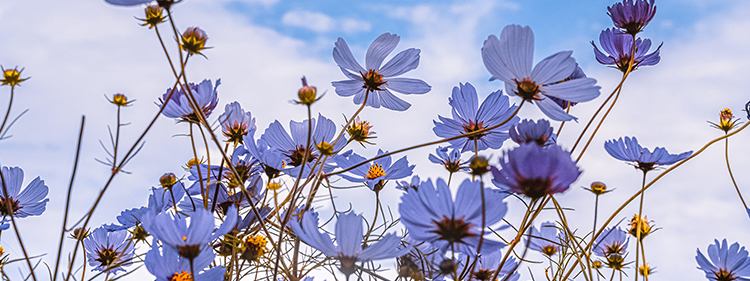
Also known as sky blue aster, azure aster is a beautiful flowering plant that natively grows in North America. Throughout the summer season, this plant grows into branching foliage until it produces daisy-like flowers that look dainty and captivating. Its blue flowers will keep blooming from the end of the summer until the beginning of the winter season. Instead of picking this plant from the wild, it is ideal to plant them from the seeds.
Azure aster plants can grow in Australian plant hardiness zones one to three or USDA zones seven to nine. You can access the country’s plant hardiness map from the Australian National Botanic Gardens site to learn how to convert the hardiness zones.
Azure asters grow best in areas where they get exposed to the sun, but they can still bloom in shaded locations. It’s worth noting that these flowers hate overly wet soil. They grow best in sandy, dry or rocky conditions.
2. Birdbill Dayflower
Scientific name: Commelina dianthifolia
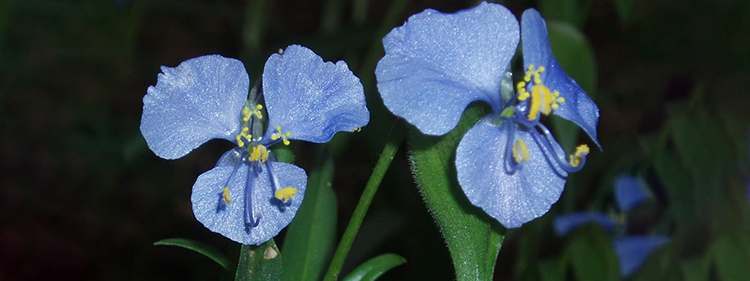
There is a wonderful reason why the bright blue blooms of birdbill dayflowers got their name. Each day, the new buds bloom by dawn and then wilt by the middle of the day. They also look so cute with their petals that look like mouse ears.
What’s great about birdbill dayflowers is how hardy they can get. Some people even consider this plant a weed. It has watery, thick stems with leaves and branches growing from its nodes.
You can see its flowers blooming throughout the summer and early autumn. Keep in mind that birdbill dayflowers grow best under the sunlight. However, they can still thrive in shaded areas.
If you have a greenhouse, you can propagate these blue flowers by seed during the middle of spring. While these blooms like moist soil, they will also survive in rocky soil. Gardeners with greenhouses propagate them in the middle of spring by seed. Birdbill dayflowers can be planted in containers, borders and rock gardens.
3. Balloon Flower
Scientific name: Platycodon grandifloras
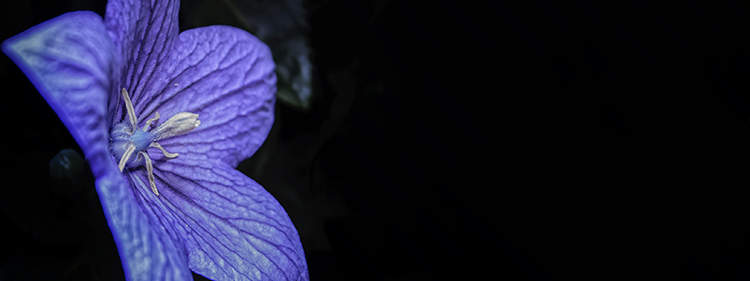
Balloon flowers are named that way for their buds that resemble balloons. These blue flowers are easy to grow and they eventually bloom into star-shaped petals. As the weather becomes a bit warmer at the end of spring, gardeners can start planting them. Throughout the summertime, the plant will continue to bloom. It can even propagate by itself.
While they don’t grow aggressively, balloon flowers can resist diseases and pests quite well. So, each year, they will always come back with beautiful blooms.
Planting balloon flowers require propagation from nursery plants or seeds. You may need to install stakes to keep the taller plants upright. Keep in mind that these blue flowers prefer being exposed to the sun. However, it can still thrive in partially shaded areas. Make sure you use loamy soil with good drainage to provide adequate moisture to the plant.
4. Bluebells
Scientific name: Hyacinthoides non-scripta

As the plant’s name suggests, bluebells are perennials that have blooms that resemble bells. Their thin stems can grow as tall as 20 inches while producing a series of bell-like flowers. Every year, people travel across the United Kingdom to see bluebells magnificently growing in their natural habitat.
In Victorian floriography, bluebells symbolize gratitude, humility and everlasting love. These days, these flowers are planted for ornamental use.
If you want blue Australian flowers that represent undying love and devotion, we recommend getting our Lustrous Lapis bouquet. Aside from stunning mums, gum, disbuds and painted monstera, this bunch also contains gypsophila which represents eternal love.
5. Blue Violet
Scientific name: Viola sororia
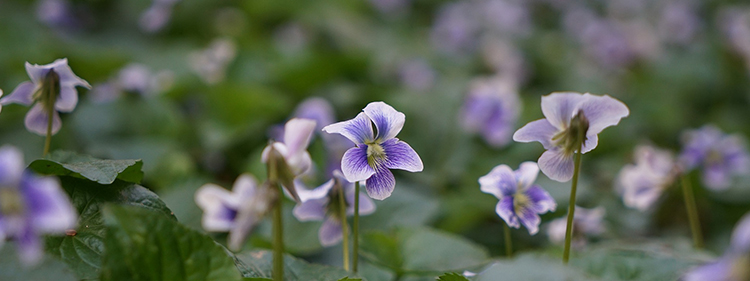
Blue violets are perennial plants that commonly grow in North America. What’s interesting about these blue flowers are their heart-shaped leaves and conspicuous white throat. Blue violets usually bloom from March to May, but they can also grow through the summer season. It’s worth noting that while these flowers can look pretty, most people consider them to be a weed.
While they grow best under areas that get plenty of sunlight, blue violets can still survive under partially shaded locations. These plants usually need moisture, but the soil needs to drain well for them to thrive. If left to themselves, blue violets can grow aggressively.
Even so, these blue flowers usually attract butterflies and birds. So, they can still be a great addition to your garden. Some people even use them as cake or cookie decorations.
6. Bluecrown Passionflower
Scientific name: Passiflora caerulea
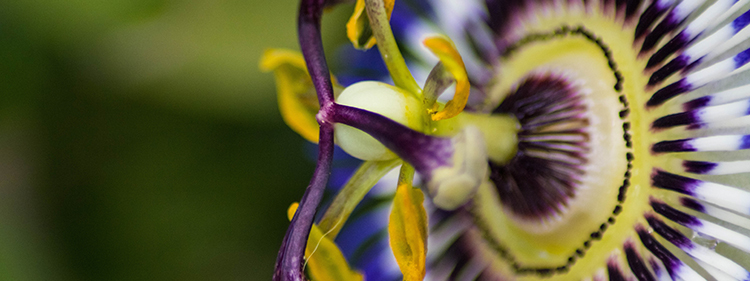
Natively growing in South America, bluecrown passionflowers have deciduous tendril vines. Even so, the plant can grow as tall as 33 feet. What’s interesting about this plant is its flowers that bloom into a stunning mandala of white and blue petals.
Bluecrown passionflowers usually latch onto the trees that are near them. The plant also produces fruits that some people put in teas. However, while they look harmless, they contain cyanogenic glycosides that can turn into cyanide. According to the NSW Department of Primary Industries, eating the plant’s fruit can cause vomiting and nausea. While poisoning is not common, the ripe fruit still contains traces of toxins.
7. Blue Star
Scientific name: Amsonia tabernaemontana
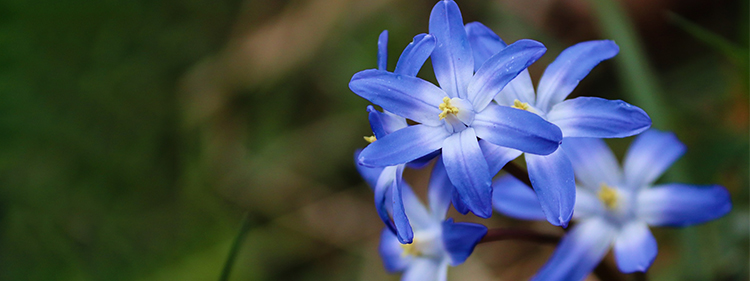
The blue star is a flowering, herbaceous perennial plant that usually grows in open woods and thickets. It can be an excellent addition to any garden because it looks beautiful and yet it is easy to maintain. Blue stars thrive in adequately drained soil. Even so, they can still survive dry seasons.
Blue stars prefer the full sun, but they still do well in partly shaded areas. When they get sunlight throughout the day, they don’t usually need staking or pruning. Be warned that if you plant these flowers in rich soil, they may droop.
Blue stars continue to bloom from March to May, and they usually grow between two to three feet tall. Even if you’re a first-time gardener, you can easily plant blue stars. As we’ve mentioned, they do not need a lot of attention or maintenance.
8. Chicory
Scientific name: Cichorium intybus
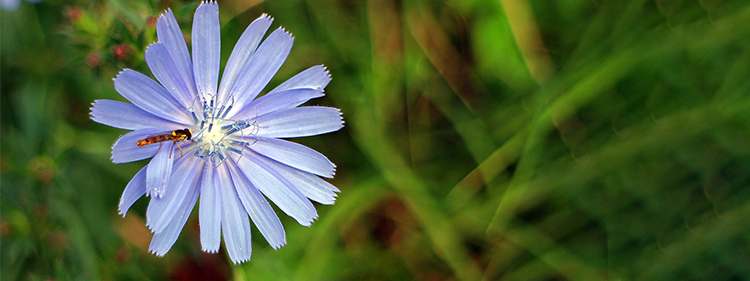
While chicory is sometimes seen as a weed, it still has stunning, dainty blue flowers. This is also the reason why many people cultivate this biennial or annual plant. The chicory flowers develop 10 to 20 ray florets and they are usually an inch across. Its flowers usually bloom in the morning and close in the afternoon.
Chicory plants thrive under the sun, and they can survive in most types of soils. However, they grow better in clay-mixed soil. Moreover, the plant can tolerate alkaline soils and road salt. Besides, it does not need too much water. While chicory flowers thrive in moist soil, they can still withstand drought. Sometimes, gardeners grow it for use in teas or salads.
9. Clematis
Scientific name: Clematis

Clematis is a stunning vine that grows blue flowers. It is one of the hundreds of species within the buttercup family Ranunculaceae. Over the years, flowers in this genus have been known under different names. Some people refer to clematis as leather flower, vase vine, or traveller’s joy. They’re usually given names that reflect the characteristics of the location where they’re grown.
It’s worth noting that clematis is an ancient Greek word that means “climbing plant”. The flowers look even more magical because of their enigmatic vines.
Clematis grow best under the full sun. So, it’s ideal to plant them during the spring to let them get plenty of sunlight. Also, they thrive in moist and adequately drained soil.
10. Columbine
Scientific name: Aquilegia

Columbines are beautiful perennial plants that bloom blue flowers resembling bells. From the middle of the spring through the summer, this plant continues to blossom. So, there’s a good chance that you’ll enjoy its wonderful flowers until the beginning of autumn. You’ll see columbines in a wide range of sizes and they usually grow up to three feet tall. However, some dwarf varieties do not grow beyond six inches.
Columbines thrive under the full sun, but they can still survive under partially shaded areas. These blue flowers love well-drained soil even if its quality is average. Butterflies, bees, and birds will naturally flock a garden with columbines because the flowers’ nectar is a delight to drink.
It’s quite easy to grow columbines because they survive in most types of gardens. Individual plants usually live for around three years or so. However, they are self-seeding which allows them to propagate without external help. Gardeners usually plant columbines during spring for the best chances of survival.
11. Cornflower
Scientific name: Centaurea cyanus
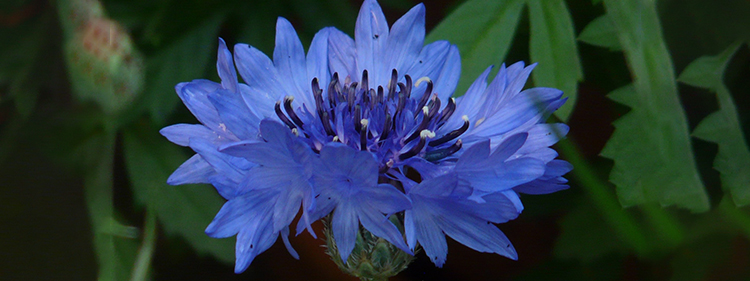
Also referred to as bachelor’s buttons, cornflowers are annual flowering plants that are native to Europe. Belonging to the Asteraceae family, these blue flowers were thought of as weeds that commonly grew in cornfields.
Unfortunately, because of herbicide overuse, cornflowers are becoming endangered in their native environment. Even so, they have been growing naturally in other parts of the globe. Many people believe that cornflowers have anti-inflammatory benefits.
Beautiful cornflowers were mentioned in folklore as a romantic symbol for young men pining over their special someone. However, in Germany and Austria, it has a complicated history. In the 1930s, Nazis wore cornflowers as a secret symbol for recognizing each other.
12. Daisy
Scientific name: Felicia amelloides
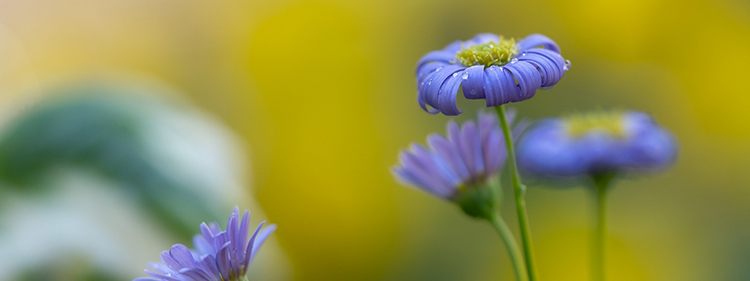
You might be familiar with white daisies, but did you know that these herbaceous perennials also bloom in blue? These blue flowers have a stunning yellow centre, and they thrive under the full sun. Furthermore, they are easy to plant and grow. Blue daisies only need moist and well-drained soil to survive. However, they prefer a temperate climate over extreme cold or heat.
You can enjoy the wonderful radiance of blue daisies throughout the summer. When they bloom, they attract various kinds of butterflies. So, having them in your garden gives you a beautiful show during summertime.
As we’ve mentioned, blue daisies are quite resilient. It’s also fairly easy to grow them from seeds. However, make sure you do so as the weather becomes warmer. This way, they will grow well throughout the summertime.
13. Desert Bluebells
Scientific name: Phacelia campanularia

Also referred to as desertbells, desert bluebells are flowering plants that belong to the Boraginaceae family. Other names given to this flower include California bluebells and desert scorpionweed. They are commonly found in dry and hot regions like the Sonoran, Californian, and Mojave deserts. Even so, they are cultivated in other parts of the world.
Desert bluebells usually grow a little over two feet tall, but they create beautiful foliage anywhere they bloom. It’s worth noting that these blue flowers are already classified as vulnerable plants in their native environment. So, it is generally discouraged to remove them from their natural habitats.
If you want to grow desert bluebells, you can do so by propagating them from seed. Also, they spread naturally. So, they do not need constant care and maintenance. In some cases, all you need to do is sprinkle the seeds randomly and they will grow on their own.
14. Dwarf Morning Glory
Scientific name: Evolvulus
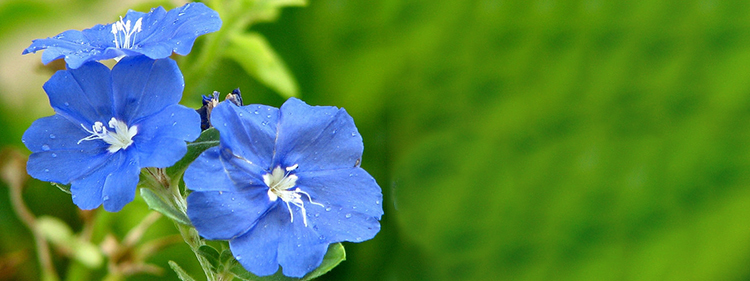
You’ll commonly find dwarf morning glories in lavender and blue colours. This herbaceous perennial plant loves to bloom under the full sun, but its flowers close at nightfall. It grows well in well-drained and organically rich soil. Usually, they reach up to three feet tall and they cover the ground as long as they are properly pruned.
You can enjoy the beautiful blooms of dwarf morning glory from summertime to fall. It can also survive drought. So, even if you don’t water it every day, it will continue to thrive. You don’t even have to deadhead the plant because it naturally gets rid of dried blooms.
You can use softwood cuttings or seeds to propagate dwarf morning glory. Now, if you want to manage the growth direction and rate of the plant, you should prune it.
15. Empire Blue Butterfly Bush
Scientific name: Buddleja davidii ‘Empire Blue’
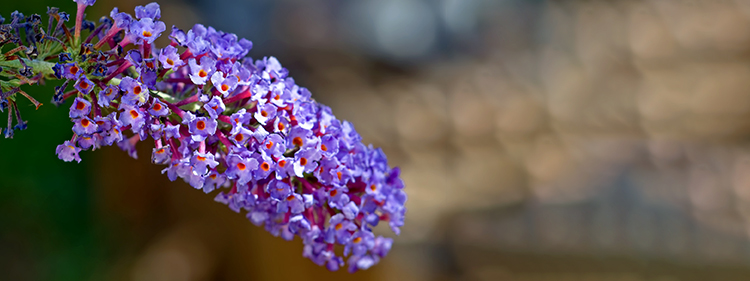
Empire blue butterfly bush is a deciduous and vigorous shrub with white felted undersides and lance-shaped leaves. Its elongated panicles have stunning violet-blue flowers that are clustered together, creating an intensified, sweet scent. So, when you have this planted in your garden, expect the blooms to fill the air with a delicious smell.
The empire blue butterfly bush has blooms that last long, making it ideal for floral arrangements. The scent of this plant and its wonderful colour also attract pollinators. So, you’ll likely see bees and butterflies in your garden when its flowers are in full bloom.
16. Fairy Thimbles
Scientific name: Campanula cochlearifolia
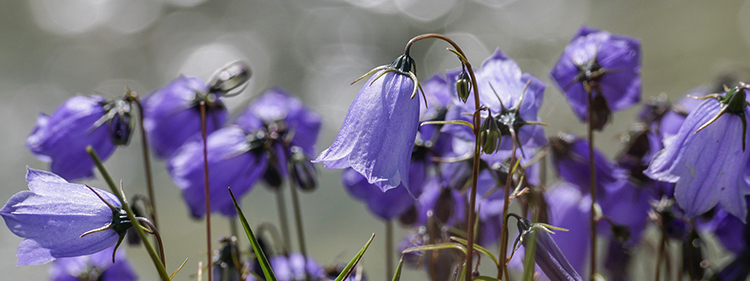
Belonging to the bellflower family, fairy thimbles are low-growing rhizomatous perennial plants. They are native to the French Massif Central, Alps, Pyrenees, and Carpathian Mountains of Central Europe. Fairy thimbles grow around three to six inches tall and they spread up to two feet across. They thrive under the full sun, but they can still survive under partially shaded areas.
Fairy thimbles also like well-drained, medium-quality soil. So, they’re unlikely to survive in dry and hot areas. However, under ideal conditions, they are quite easy to grow.
Make sure you plant them in alkaline or neutral soil and keep it moderately moist. Also, they propagate on their own. As such, they will keep coming back every year. Usually, they bloom from the end of spring towards the middle of summer.
17. Blue False Indigo
Scientific name: Baptisia australis
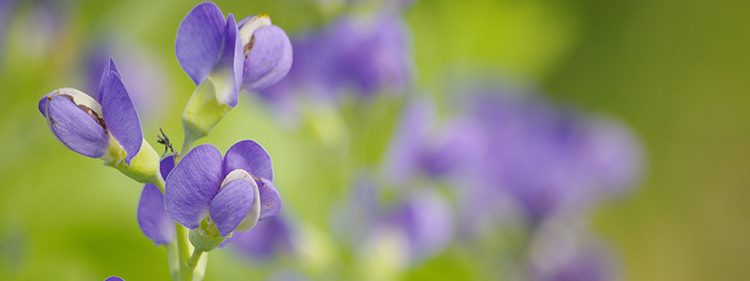
A member of the Fabaceae family, blue false indigo is a flowering plant that is native to North America. You’ll usually find them at the edge of densely forested areas. Its stems are quite similar to bluebells in the sense that they grow like tall blades of grass. Its blooms grow along the vertical stem in a deep blue-purple hue.
Cherokees and other American Indian tribes used to plant blue false indigos for dying textiles blue. They also used to keep the seeds of this plant for creating rattle toys for kids.
18. Flax
Scientific name: Linum usitatissimum
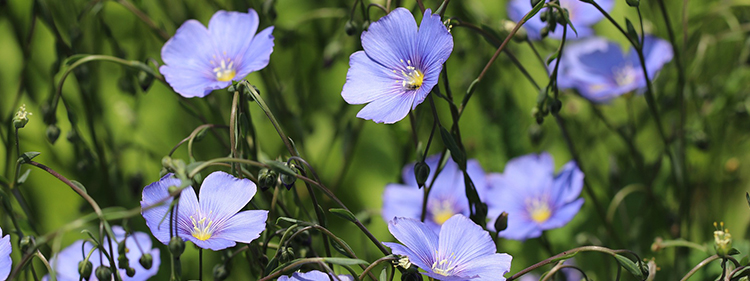
A member of the Linaceae family, flax is a flowering plant with pale blue blooms. However, you will also find varieties that are red, yellow, or white.
This plant is cultivated around the globe for many uses. Throughout history, its seeds have been used for medicinal purposes. Studies have been done to uncover the health benefits of this superfood. So, it’s not uncommon to find the seeds of these blue flowers in local supermarkets.
Aside from being a superfood, flax seeds also have other uses. For instance, the flower produces linseed oil that is popularly used for varnishing or painting wood. Flax is even used to make linen for clothing and sheets.
19. Forget-Me-Nots
Scientific name: Myosotis scorpioides
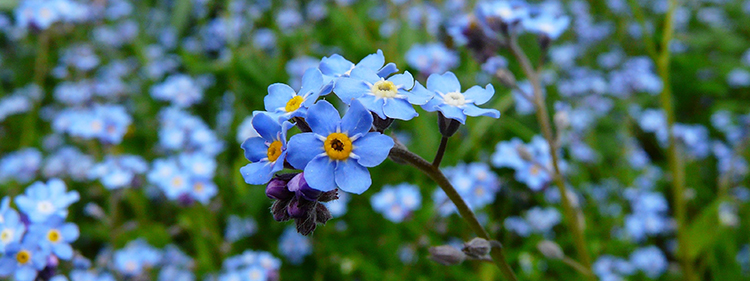
Forget-me-nots are herbaceous perennial plants with beautiful flowers. They natively grow in Europe and Asia, but they can now be found in some parts of the United Kingdom and the United States.
However, it’s worth noting that while forget-me-nots have wonderful blue flowers, they are considered weeds in some parts of the US. So, if you want to plant it in the US, make sure you check the local regulations in your area.
Forget-me-nots thrive in damp habitats like streams and bogs. Even so, experienced gardeners can cultivate them in rich soil with great moisture. They usually reach up to a foot tall and they end up forming lily pad-looking rafts when they grow along streams. Before they bloom into a vibrant shade of blue, the small flowers of forget-me-nots start off pink.
It’s easy to grow forget-me-nots because these blue flowers require little to o maintenance. However, while they attract butterflies, they need to be properly managed. Otherwise, they will quickly take over your garden.
20. Gentian Flower
Scientific name: Gentiana

A member of the Gentianaceae family, the gentian flower blooms into a bold, deep shade of blue. They look like trumpets with cute, yellow centres. Their stunning blue colours make them a wonderful focal point for your garden.
The gentian flower naturally grows in Europe, alpine regions in Asia, and various areas in the Americas. Unfortunately, it cannot be considered to be among the most common blue Australian flowers. You will rarely find it in nurseries across the country.
Gentian flowers prefer rocky soil that is well-drained and moist. You don’t need to water the plant frequently as it can tolerate drought. Furthermore, it is easy to maintain, especially since it does not attract pests or diseases.
Gentian flowers easily cover the ground because they usually grow up to six inches only. When you plant them, you can expect blooms from May to June.
21. Globe Thistle
Scientific name: Echinops

You’ll find it interesting to grow globe thistles because of their spiky leaves and purple-blue, round flower heads. They’re a great addition to any garden, especially for people who prefer low-maintenance plants.
Globe thistles start to bloom at the end of summer. If you want to keep the plant healthy, you need to prune it a bit after it produces flowers. Doing so usually brings a new set of blooms.
This plant prefers well-drained, moist soil. Even so, it can tolerate drought quite well. Furthermore, it is resistant to most diseases and pests which makes it easy to care for. However, you need to prune it from time to time because it tends to grow up to five feet tall.
Globe thistles are also self-sowing. So, you can expect them to come back year after year. Now, if you’re pressed for time and you want blue flowers, you can opt for our Ice Blue bouquet. This arrangement has beautiful, blue gypsophila that almost look like tiny globe thistles.
22. Glory-of-the-Snow
Scientific name: Chionodoxa forbesii
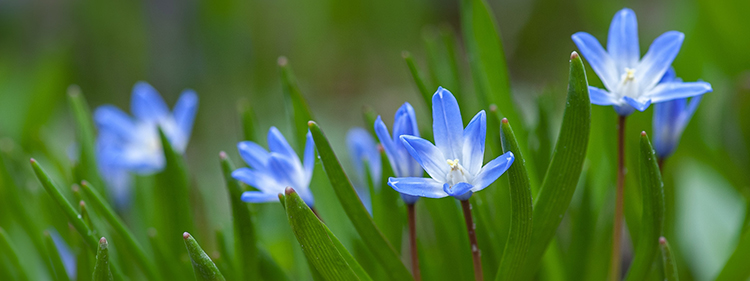
Glory-of-the-snow got its name because this perennial plant blooms early in the year that its flowers peek right out of the snow. Aside from having blue flowers, this plant also has pink and white blooms. You’ll usually see them in eastern Mediterranean locations like Cyprus, Turkey, and Crete.
Glory-of-the-snow flowers grow up to six inches tall. So, they become great ground cover when they are in full bloom. They thrive under the full sun, but they can also survive in partially shaded areas.
You’ll need well-drained soil with leaf litter or compost for optimum porosity. Once they start growing, caring for glory-of-the-snow flowers is virtually effortless. You only have to fertilise early in the spring to make sure they grow well throughout the spring season.
23. Grape Hyacinth
Scientific name: Muscari
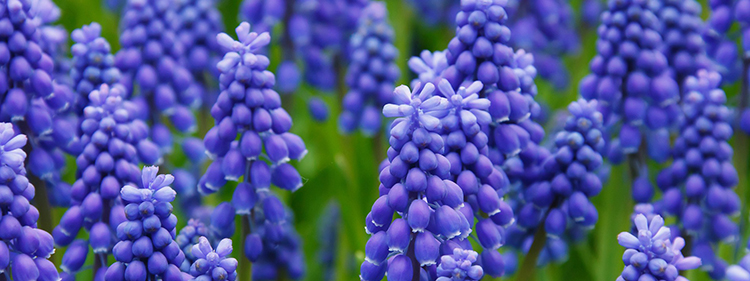
You’d love the tiny, bell-shaped blooms of grape hyacinths. They’re like upside-down versions of the snapdragon bulbs in our Azure Lustre floral arrangement. These low-growing plants have flowers that grow in grape-like clusters.
Aside from blooming in wonderful shades of purple-blue, grape hyacinths also smell quite sweet. You’ll enjoy their scent throughout winter and the end of the spring if you plant them during the fall season.
Grape hyacinths thrive under the full sun, but they can also bloom in shady areas. They prefer well-drained, moist soil. Furthermore, they’re easy to care for because they can tolerate pests and diseases quite well.
You need to prune the plant adequately to avoid re-seeding. It grows best in areas near streams and ponds, and in rock gardens and formal beds, also in planters and pots.
24. Harvestbells
Scientific name: Gentiana Saponaria

Also known as soapwort gentians, harvestbells are perennial wildflowers that usually grow in bogs, marshes, moist woods, roadsides, and stream banks. They belong to the Gentianaceae family and they natively grow in North America, particularly in New York, Wisconsin, Texas, Florida, and North Carolina.
Most of the time, harvestbells grow in sandy soil under full or partial sun. Even so, it can still thrive in most kinds of soil, including fertilised loam. You can expect it to grow up to two feet tall from September to November. These purple-blue flowers will look great in your garden along with other plants that bloom in autumn.
25. Himalayan Blue Poppy
Scientific name: Meconopsis betonicifolia

Himalayan blue poppies are stunning flowering plants that create a wonderful show from the end of spring to early summer. They grow well under partial shade, but they will also thrive in a completely shaded garden. However, Himalayan blue poppies are not for amateur gardeners. These flowers can be finicky about the conditions in their environment.
For instance, you need to ensure that the soil is neutral to slightly acidic. While the soil should be moist, it should also drain well. Gardeners also add humus to the soil to enrich the plant and promote its growth.
Himalayan blue poppies prefer cooler summer temperatures and don’t grow in hotter climates. Note that they are perennial plants. So, after the fall season, you should cut them down. After all, they attract snails, slugs, and diseases.
26. Hyacinth
Scientific name: Hyacinthus orientalis
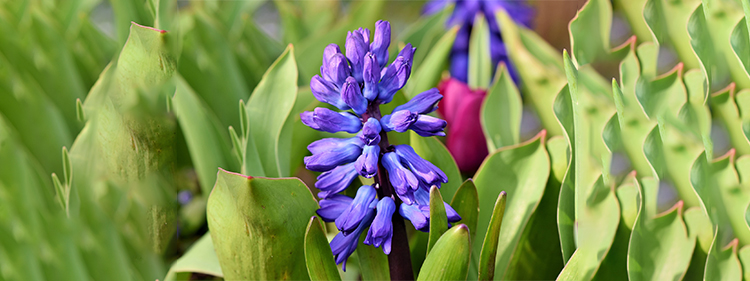
Hyacinths are spring-blooming, bulbous perennial plants with flowers that come in different colours. These fragrant blooms commonly come in pink, white, and purple-blue. They prefer growing in organically rich soil under the full sun.
Gardeners can expect them to bloom excellently as long as they keep the soil moderately moist. They start producing flowers in the middle of spring, then continue to do so for up to three weeks.
Usually, hyacinth plants grow up to ten inches tall. As long as you give them what they need, they are relatively easy to cultivate. Now, if you want to see their blooms as early as possible, make sure you plant them in the autumn. Don’t forget to mulch their beds so that they have adequate protection from the winter frost.
27. Hydrangea
Scientific name: Hydrangea macrophylla
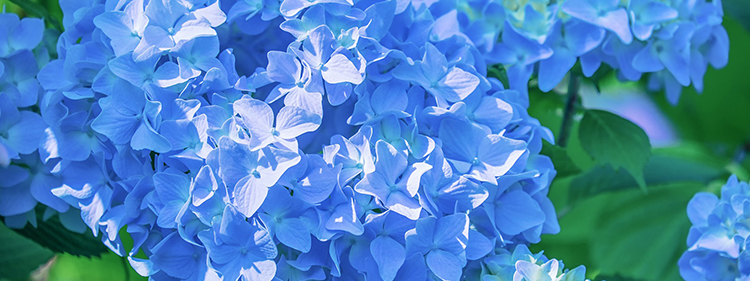
While blue hydrangea is native to Japan, this deciduous plant can also be considered among the most popular blue Australian flowers. After all, it’s not uncommon to find them growing in many suburbs in the country.
You’ll easily spot this plant because of its expansive heads of blue blooms. Usually, this shrub produces flowers in the summer. The flower heads tend to grow outward in various directions. So, the shrub naturally appears to have round bursts of bright blue blooms.
It’s worth noting that hydrangea also produces pink blooms depending on the pH level of the soil. If you want to keep the flowers purple or blue, make sure you use acidic soil. Otherwise, the blooms will turn red or pink in alkaline soil.
However, no matter what colour they turn out, these flowers still make a stunning option for arrangements. Take our Hydrangea Bouquet as an example. Handmade by expert florists and sourced fresh daily, this bouquet is available for same-day delivery!
28. Impatiens Flower
Scientific name: Impatiens namchabarwensis
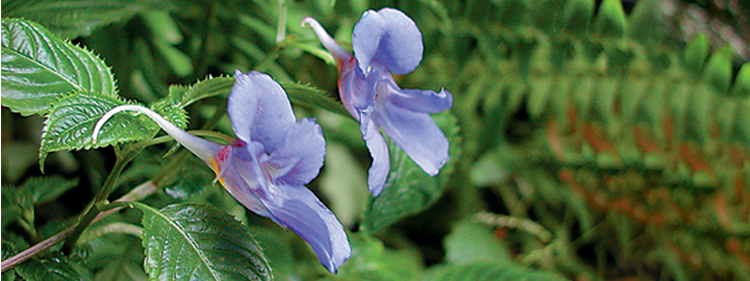
You’ll find the impatiens flower in various hues, including red, orange, white, and pink. However, the one that blooms in bright blue colours is the Impatiens namchabarwensis. They usually thrive under the full sun, but they will still survive under partially shaded areas. Furthermore, they grow better in well-drained, evenly moist, and organically rich soil.
Throughout the spring and summer seasons, this plant produces stunning blooms. It also grows up to two feet tall. However, it can be sensitive to frost. So, make sure you mulch its bed to keep it safe during the harsh, cold season.
The impatiens flower self-sow annually in areas that experience colder winters. However, it becomes a perennial plant if it grows in areas with milder winters. If you decide to cultivate it, you must give it the care it needs. You can plant it in containers and beds, but it would need constant maintenance.
29. Iris
Scientific name: Iris sibirica
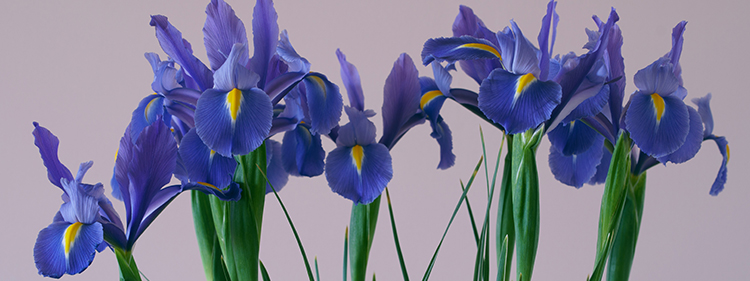
Also known as Siberian flag or Siberian iris, Iris sibirica is a flowering perennial plant with grass-like leaves and tall stems. It is native to several Eastern European countries, but it is also widely cultivated in various areas in Central Asia.
Usually, the flower has two to five petals with bright purple-blue colours. Some of the petals may stand up, but the rest arch downward.
Irises grow best in medium-moist to wet soil. So, gardeners typically find it challenging to give the plant the care it needs. After all, it doesn’t tolerate pests and diseases quite well.
However, once they start to bloom, irises can be quite stunning.They make excellent accents for arrangements, as our expert florists did for Blue Heaven.
30. Larkspur
Scientific name: Delphinium
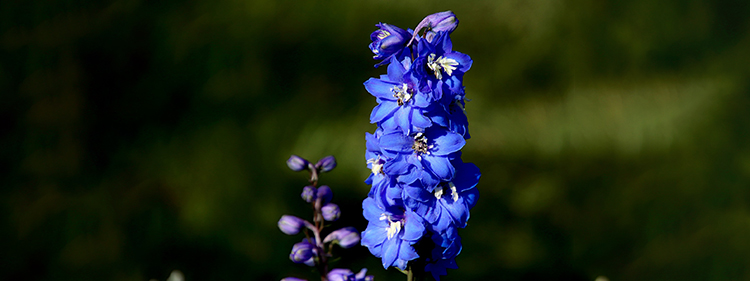
You’ll find larkspurs in various colours, including purplish-blue. They usually grow up to four feet tall, producing blooms from June to July.
Larkspurs prefer growing under the full sun and in rich, fertilised soil that drains well. While they like sunshine, they grow best in cooler climates. They can tolerate a little warmth as long as the area is partially shaded.
If you’re planning to cultivate this plant, you’ll need to stake it since it can grow so tall. The taller varieties will stay upright when you stake them with bamboo sticks and string. Also, you can retain enough moisture by mulching the beds of the plant. You can promote healthy growth by adding compost.
Now, if you don’t have time to cultivate larkspurs yet you want to appreciate their beauty, we recommend getting our Blue Skye Vase arrangement. Aside from having wonderful delphiniums, this bunch also includes stunning irises, orchids, disbuds, and other blue Australian flowers.
31. Lead Plant
Scientific name: Ceratostigma plumbaginoides
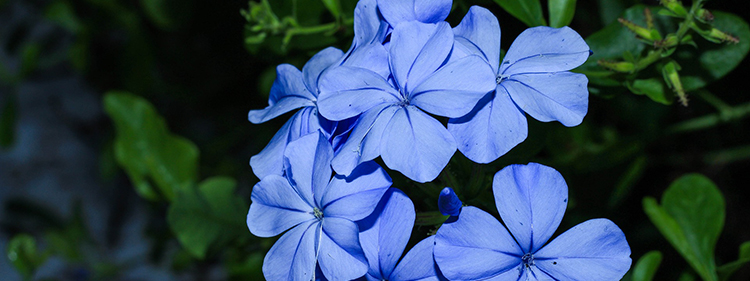
Also known as leadwort or plumbago, the lead plant is an herbaceous perennial with hardy, blue flowers. It only begins to bloom towards the end of the summer or the beginning of fall.
The bright green leaves on its red stems also turn red before they fall in the autumn. Since the plant is low-growing, it makes a great ground cover.
The lead plant thrives under the full sun and in well-drained soil. Most gardeners cultivate this plant for ornamental purposes. However, some also grow it to control soil erosion.
It’s worth noting that leadwort has received the Award of Garden Merit from the Royal Horticultural Society. This means that this plant is quite easy to cultivate for its stable form, resistance to diseases and pests, and good constitution.
32. Lily of the Nile
Scientific name: Agapanthus africanus
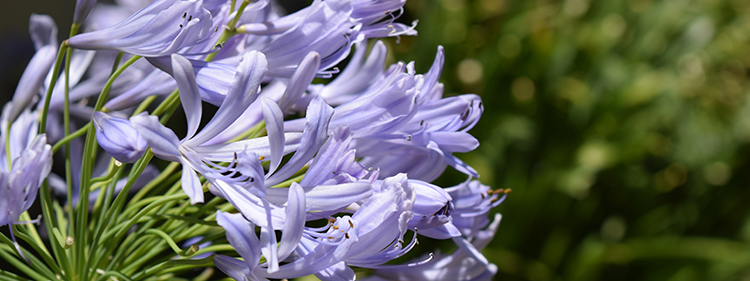
Showy, alluring and bright, the lily of the Nile is a flowering plant that natively grows in the rocky sandstone slopes of the Cape Peninsula and South Africa. It produces clusters of funnel-shaped flowers that bloom from the beginning to the middle of the summer season. It will grow beautifully as long as it gets at least six hours of direct sunlight.
You can grow it in the country, but do know that it is one of the blue Australian flowers that do not do well in extremely hot locations. So, if it gets sweltering in your area, it may not be a good idea to plant lilies of the Nile.
Make sure you use well-drained, slightly moist, and fertilised soil. Also, if you’re specifically cultivating Agapanthus africanus, you should use acidic soil.
Lilies of the Nile usually grow up to two feet tall, producing blooms throughout June and July. To promote proper growth, you must regularly water the plant. However, you should stop doing so once you notice the foliage turning yellow. Furthermore, lilies of the Nile grow better in containers instead of in the ground.
33. Lobelia
Scientific name: Lobelia

Lobelia is a genus that encompasses hundreds of flowering plants that grow best in tropical or warm climates. This plant has perennial and annual shrub variants that grow in various colours, including a deep, purplish blue.
Once you start researching lobelias, you will notice that no two varieties are alike. Every flower in the genus possesses unique qualities that separate it from other variants.
Many gardeners love to plant this genus, especially for its blooms that come in different bold hues. Also, the species lobelia inflata, which is native to North America, is believed to have medicinal properties. Some cultures dry the flower and use it as an expectorant. However, it is also considered a potentially poisonous herb since it can cause vomiting, nausea, profuse sweating, and other issues.
34. Love-in-a-Mist
Scientific name: Nigella damascena

When you plant love-in-a-mist, you will have annual shrubs that bloom stunning blue flowers. This plant usually grows up to 20 inches tall and 18 inches across.
Love-in-the-mists usually thrive under the full sun, but they will still survive under partial shade. Make sure you plant them in well-drained and fairly moist soil with an average pH level.
The plant begins to bloom from the end of spring and continues to do so until the beginning of autumn. You can encourage the shrub to grow more blooms by deadheading the flowers. What’s great about love-in-the-mist is its resistance to pests and diseases. So, it is easy to cultivate and maintain.
35. Lungwort
Scientific name: Pulmonaria
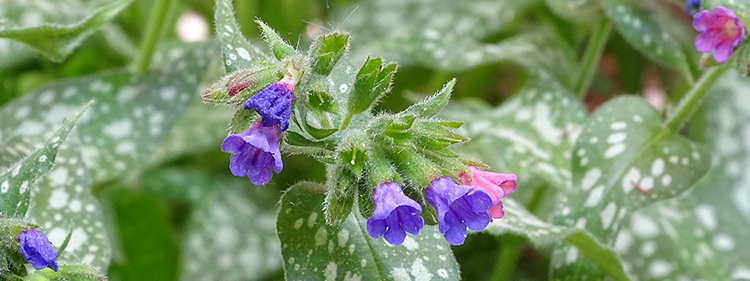
More popularly known as Blue Ensign, lungwort is a flowering plant that natively grows in western Asia and Europe. The origin of this plant’s name is the Latin word “pulmo” which translates as “lungs”.
You’ll notice rough hairs across the leaves of this plant. So, when you touch them, you’ll feel their bristly texture. In popular culture, the leaves of the lungwort plan were believed to symbolise diseased lungs.
Lungwort grows best under partially shaded areas. However, the plant does not thrive if it is planted by a tree. Also, it has to be watered consistently to ensure that it will stay healthy.
36. Lupine
Scientific name: Lupinus
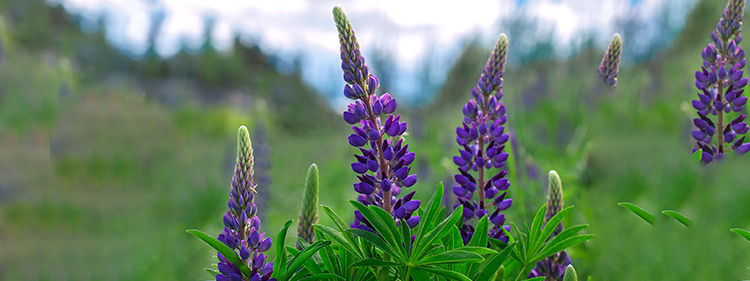
It’s interesting to look at lupines especially when they begin to bloom blue flowers. This herbaceous and partly woody plant usually grows up to four feet tall. Its varieties are available as annual or perennial plants which are best cultivated in pots.
Ideally, they should be planted as seeds in the late fall or spring. Once they begin growing, you can plant the cuttings in the middle of the spring.
If you want to get the best results, make sure you expose your lupines to direct sunlight. Furthermore, you should plant them in rich, well-drained, and moderately moist soil. If properly taken care of, lupines can bloom for a long time—usually throughout the spring and summer seasons.
Lupines do not like overly humid or hot summers, especially since they grow in temperate climates. If they’re exposed to too much heat, they may not produce flowers. So, if it gets too hot in your area, you should place your lupines under a partially shaded location. These flowers may be stunning, but they require extra care. Keep in mind that they are susceptible to diseases and pests.
37. Mediterranean Sea Holly
Scientific name: Eryngium bourgatii
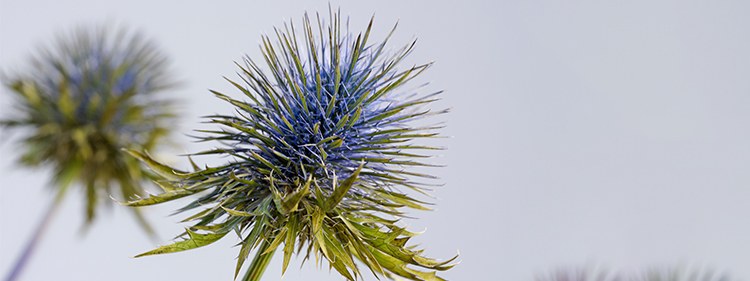
Also referred to as Oxford Blues, Mediterranean sea hollies are flowering plants that natively grow in several countries, including Lebanon, Morocco, Spain, France, and Turkey. They can also be considered blue Australian flowers because of how easy it is to cultivate them in the country.
When you see this herbaceous perennial plant, the first thing you’ll notice is its spiky appearance. Furthermore, its purplish-blue, round flowerhead resembles thistles.
The Mediterranean sea holly is hardy enough to grow in any type of soil. However, you need to water the plant from time to time. Indeed, it is easy to cultivate yet quite stunning when they begin to bloom in the middle of summer.
Now, if you can’t wait to enjoy the beauty of sea hollies, don’t hesitate to check out our Pastel Sky bouquet. This arrangement is hand-made to order by our expert florists and adorned with blooms that are freshly sourced every day.
38. Monkshood
Scientific name: Aconitum napellus

Also referred to as aconite or wolfsbane, monkshood is a plant with blue flowers that grow in clusters. It is highly toxic and poisonous to consume and touch. So, you can only appreciate its beauty from afar. However, you can easily recognize the plant because of its purplish-blue blooms and tall stems.
Despite its toxicity, it is quite easy to cultivate, which is why it has received an Award of Garden Merit from the Royal Horticultural Society.
Do note that monkshood plants grow slowly. So, they need to be planted at the beginning of spring for them to bloom by the middle or end of summer. They also need to grow in well-drained, moist soil with a neutral to acidic pH.
39. Perennial Geranium
Scientific name: Geranium bohemicum
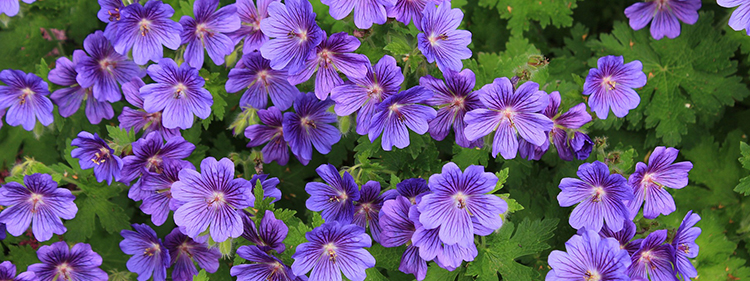
Perennial geraniums are quite popular among many gardeners because of their hardiness and beautiful purple-blue flowers. They grow best under the full sun. So, make sure to plant them in an area where they will be exposed for several hours.
Now, if you’re growing them in a location that gets extremely hot, you should cultivate them in a partially shaded area.
Perennial geraniums usually grow up to 18 inches tall, making them a lovely ground cover. They can also tolerate drought. So, you don’t have to water them too often.
Expect these flowers to bloom from May until the beginning of fall. Indeed, they can be rewarding to cultivate, especially since they produce gorgeous blue flowers for a long period.
40. Periwinkle
Scientific name: Catharanthus roseus

It’s not uncommon to find periwinkles in many garden beds, especially because of their cute appearance. This herbaceous perennial usually grows about 18 inches vertically and horizontally. So, they also provide excellent ground cover.
Periwinkles thrive in loamy, sandy, and well-drained soil. As such, you need to give the plant a good soak every week.
Also, this flowering plant prefers growing under the full sun. Even so, it will survive under partial shade, especially if it is cultivated in a hot climate. Another great thing about periwinkles is the fact that it blooms for a long period. You can expect it to produce stunning flowers from the beginning of summer until the first winter frost.
While it can survive under partial shade, it should still get adequate sun exposure. Otherwise, the plant will not bloom to its full potential. After all, periwinkles love humid and hot weather. You can propagate the plant from cuttings.
41. Poor Man’s Weather Glass
Scientific name: Anagallis arvensis
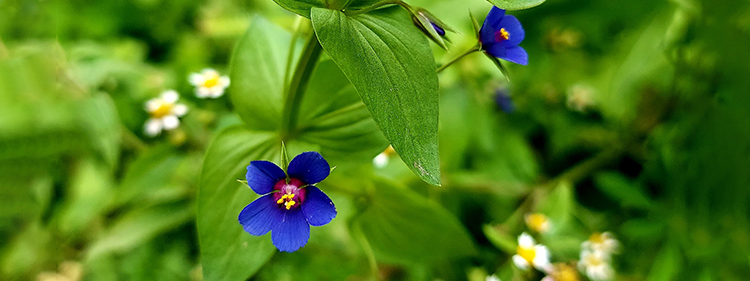
The Anagallis arvenis has many names, including poor man’s weather glass and shepherd’s clock. This low-growing, flowering plant blooms in bright shades of blue and pink.
Belonging to the primrose family, the poor man’s weather glass natively grows in Western Asia, North Africa, and Europe. However, it is among the blue flowers that can survive in various parts of the world.
Its flowers have five round petals, several yellow stamens and a purple centre. It is usually seen growing wild along the road. However, many gardeners cultivate it for the belief that it has medicinal properties. It is known to have cholagogue, diuretic, diaphoretic, antitussive, tonic, laxative and expectorant properties.
42. Rose of Sharon
Scientific name: Hibiscus syriacus
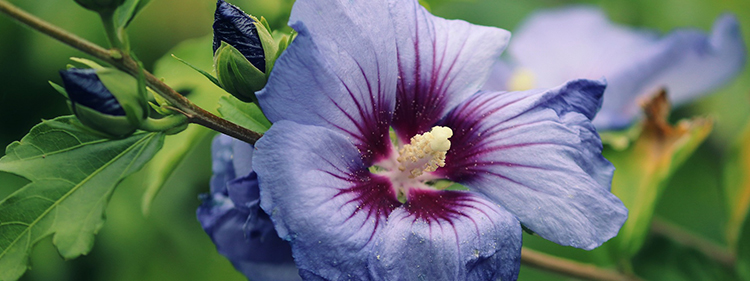
Also known as shrub althea, the rose of Sharon is a multi-stemmed, deciduous shrub with vase-shaped flowers. Compared to tropical hibiscus, this plant can survive in much colder areas.
Its name has Biblical reference, but its origin remains unclear. The rose of Sharon prefers well-drained and adequately moist soil. Moreover, you can expect it to begin blooming from July until the beginning of winter.
Remember to plant it in an area where it can get hours of sun exposure. However, you can still expect it to survive in a partially shaded location. If you’re planting with seeds, you can do so indoors. Then, you can transplant it once it reaches the ideal height. However, it is more common to purchase the rose of Sharon as a potted plant from a nursery.
43. Sage
Scientific name: Salvia officinalis

Anyone who loves to cook is familiar with the common sage. However, did you know that the herb also grows lovely, purplish-blue flowers?
The plant can grow up to two feet high and bloom throughout the summer season. Sage prefers getting full sun exposure throughout the day. So, if you’re cultivating it, make sure you place the plant in a spot where it can get enough sunlight.
You don’t have to water sage on a daily basis, especially once it’s established. The plant can survive in dry soil, but make sure you water it at least once a week. However, don’t overdo it because excessively wet soil can kill the plant. Even so, you will enjoy cultivating sage because aside from its culinary uses and beautiful flowers, it is resistant to most diseases and pests.
44. Scabiosa
Scientific name: Scabiosa
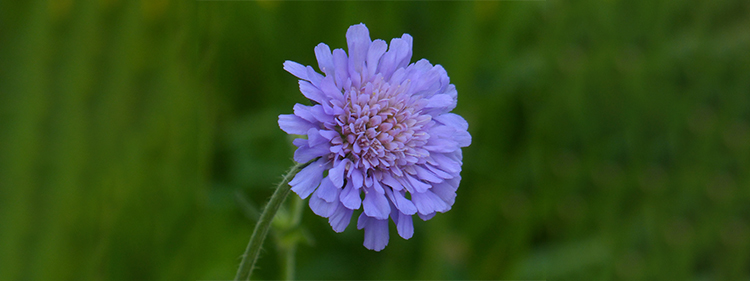
Also known as pincushion flowers, scabiosa is a flowering plant that belongs to the honeysuckle family. While it is not as attention-hogging as sunflowers and dahlias, this flower can provide character to any garden. With its strong, wiry stems and spiky ball centre, scabiosa can be used in fresh and dried floral arrangements.
The origin of its name is the word “scabious” which was a practice that involved using its blooms for treating scabies. This perennial comes in various colours and it natively grows in Africa, Asia and Europe.
Scabiosa plants grow best under the full sun. So, if you want them to bloom to their maximum potential, make sure you place them in an area where they get enough sun exposure. However, if summers get too hot in your area, be sure to plant your scabiosa in a partially shaded area.
45. Siberian Bugloss
Scientific name: Brunnera macrophylla
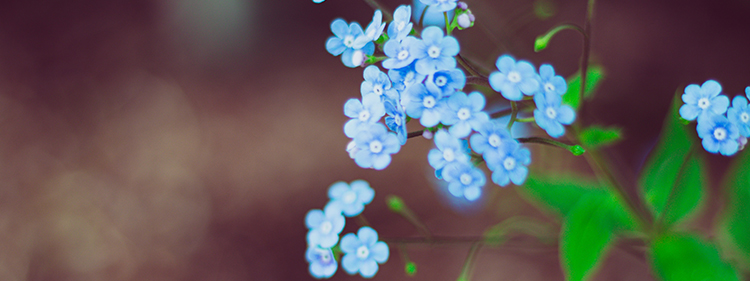
Many people confuse Siberian bugloss for forget-me-nots because of their similar appearance. Furthermore, these dainty, blue flowers offer the same charm. So, it is not uncommon for gardeners who want stunning foliage to cultivate them.
Siberian buglosses are low-growing plants that reach a maximum height of one foot. You can expect them to produce blue flowers from April to May. So, you have almost two months to enjoy the plant’s lovely blooms.
Now, make sure to plant your Siberian bugloss in a partially shaded location. If the summers get too hot in your area, your best bet is to keep the plant under full shade. Apart from those concerns, Siberian bugloss is relatively easy to care for, especially since it is resistant to most diseases and pests.
46. Sweet Pea
Scientific name: Lathyrus odoratus

Sweat peas are lovely and fragrant climbing flowers that keep blooming for several months. While they won’t cover large walls and facades, they still look beautiful growing on fences. Gardeners also cultivate them in pots, especially since they make great ornamental plants for balconies and porches.
Make sure you plant your sweet peas in an area that gets enough sun exposure throughout the day. However, if it gets incredibly hot in your location, the plant will do better under partial shade.
You can create climbing aids made of wire mesh or trellises with narrow grids to promote your sweet pea’s growth. It is relatively easy to cultivate this plant which is why it has received the Award of Garden Merit from the Royal Horticultural Society.
47. Triplet Lily
Scientific name: Triteleia laxa
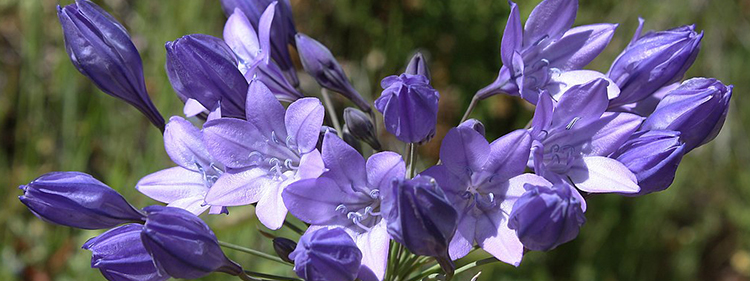
From the end of spring towards the beginning of summer, triplet lilies bloom in a wonderful shade of purple-blue. They usually grow up to 18 inches in height and produce funnel-shaped flowers. These herbaceous perennials are commonly cultivated from tubers or bulbs. However, once established, they will produce beautiful blooms each year.
Triplet lilies grow best under the full sun. So, make sure that they get enough exposure to the sun throughout the day. Moreover, the soil should be sandy, light, fertile, and well-draining. If it gets colder in your area, don’t forget to mulch the flower bed to protect the plant from dropping temperatures.
It is relatively easy to grow triplet lilies no matter what your gardening skill level is. Furthermore, they are fairly resistant to pests and diseases. However, they usually attract butterflies. So, you’ll likely have a good show throughout the plant’s blooming season.
48. Veronica Georgia Blue
Scientific name: Veronica Umbrosa

Veronica Georgia blue is a semi-evergreen perennial plant that produces a low cushion of blue flowers. It blooms throughout the spring season as long as it gets enough exposure to the sun. You can expect it to grow up to six inches tall, spreading up to two feet across. So, it can adequately cover the ground if you propagate it.
Furthermore, Georgia blue flowers do not require too much maintenance. You can get it to bloom abundantly without having to toil endlessly. Make sure you plant it in a location that gets full sunlight throughout the day. It will also thrive in well-draining, moist, and average soil.
They look stunning when you plant them as garden edges. Even so, you can also cultivate them in containers to make lovely accents for your balcony or porch. However, they look incredibly beautiful when they are planted in groups.
Another thing you’ll love about these blue flowers is that they are quite resistant to most diseases and pests. So, they are relatively easy to care for. Besides, they usually attract small birds and butterflies. As such, you can expect a wonderful show in your garden when they bloom throughout springtime.
FAQs About Blue Flowers
Q: What do blue flowers mean?
Throughout history, blue flowers have been associated with various meanings and symbols:
- In psychology – The colour blue symbolises serenity, peace, and calmness.
- Ancient Egypt – Blue signified the elite class and royalty of pharaohs.
- Ancient Rome – The colour blue was associated with the blue war paint that Celts wore in battle.
- 18th century Europe – Blue flowers symbolised social change and a flourishing society.
- Modern meaning – These days, blue flowers are associated with desire, love, hope, creativity, grand ambitions and beauty.
Q: What is the most common blue flower?
Among the blue Australian flowers, hydrangea is probably the most popular, if not the most common. It is usually the first plant that comes to mind when people think about blue flowers.
Q: What flowers are commonly blue?
There are several flowers that come in hues of blue and deep purple-blue. However, here are some of them:
- Morning glory
- Hydrangea
- Blue Anemone
- Clematis
- Bluebells
- Native blue lupine
- Geranium
- Iris
Q: What is the rarest blue flower?
One of the rarest blue flowers in the world is the Himalayan blue poppy. Native to Tibet, this plant is notorious for being incredibly difficult to cultivate. It has to be planted under specific weather conditions and soil acidity.
Q: What flower is blue all year round?
Here are some of the blue flowers that bloom throughout the year:
- Plumbago
- Butterfly pea
- Verbana
- King’s mantle
Get Your Lovely, Blue Australian Flowers from Flowers Across Melbourne
These are just some of the many blue flowers that people adore across the world. Now, if you are in Melbourne and you want to appreciate the beauty of blue blooms, check out our Azure Allure collection. We have several arrangements that feature some of the most beautiful blue Australian flowers, including sea hollies and irises. We also use coloured gypsophilas, disbud’s, and chrysanthemums.
So, no matter what the occasion, get your wonderful blue flowers from Flowers Across Melbourne today.




No Comments